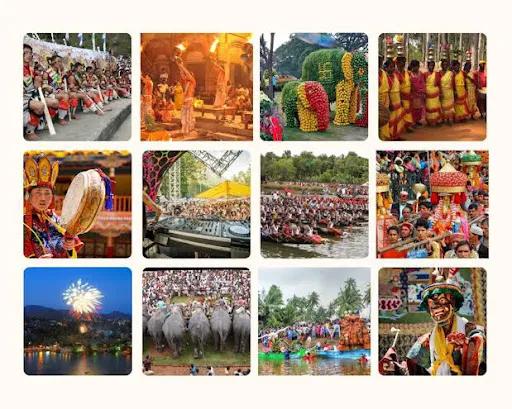Chapter 3: Fairs and Festivals of the Hills
Festivals in Himachal Pradesh are not just celebrations—they are spiritual rituals, social gatherings, agricultural markers, and windows into the vibrant culture of the land. Rooted in mythology, religion, seasonal rhythms, and community life, these festivals breathe color and life into the hill state throughout the year. Whether religious or folk in origin, each fair and festival in Himachal is a reminder of the people’s close connection to nature, divinity, and heritage.
3.1 Celebrating the Divine in Daily Life
Almost every festival in Himachal revolves around local deities, spiritual traditions, or seasonal changes. These are deeply personal events for the locals, and tourists fortunate enough to witness them often feel transported to another time.
Each region has its own patron deity, and most festivals involve ceremonial processions, ritual dances, music, and offerings. The deities are believed to join the festivities through idols or palanquins, and villagers gather to seek blessings, narrate tales, and celebrate their faith.
3.2 Famous Fairs and Festivals Across the State
Kullu Dussehra (Kullu)
One of the most iconic festivals of Himachal, Kullu Dussehra starts when the rest of India ends its Dussehra celebration. Deities from hundreds of nearby villages are brought in colorful processions to the Dhalpur Maidan in Kullu. The week-long celebration features traditional dance, music, and spiritual rituals, culminating in the burning of Lanka.
Minjar Fair (Chamba)
Celebrated in the Chamba valley, Minjar marks the ripening of maize and paddy. It includes processions, wrestling bouts, and cultural performances. Devotees offer silk threads (minjars) to the Ravi River as a symbol of prosperity and a prayer for good harvest.
Shivratri Fair (Mandi)
Known as the "Mahakumbh of the Devtas," Mandi Shivratri gathers hundreds of deities and thousands of devotees in the temple town of Mandi. The festival is marked by spiritual processions, fairs, night-long singing, and folk dances.
Lavi Fair (Rampur)
Once a major trade fair between Tibet and Himachal, the Lavi Fair is held in Rampur Bushahr. Traders still arrive from Spiti, Kinnaur, and nearby regions, and goods like wool, dry fruits, and horses are exchanged.
3.3 Regional Festivals and Community Gatherings
Phagli (Lahaul-Spiti, Kinnaur)
Held during late winter, Phagli is a masked festival where locals wear traditional clothes and perform folk dances to ward off evil spirits and welcome the new agricultural cycle.
Losar (Spiti and Buddhist Regions)
Celebrated as the Tibetan New Year, Losar marks the end of the winter season with prayer ceremonies, monastery dances, cleaning rituals, and traditional food. Monks perform Cham dances in full costume, representing various protective deities.
Halda (Lahaul)
A festival similar to Diwali, Halda involves the lighting of cedarwood torches, symbolizing unity and community bonding. Families gather together to share meals and prayers for prosperity.
Sazo (Kinnaur)
Celebrated in January, Sazo marks the departure of local deities to heaven. Devotees bathe in hot springs or rivers, light lamps, and offer prayers and flowers.
3.4 Agricultural and Seasonal Celebrations
Baisakhi
Observed in mid-April, Baisakhi marks the harvest season. Farmers rejoice with folk dances like Bhangra and Nati, feasting and offering thanks for nature’s bounty.
Magha Saaji (Winter New Year)
A winter solstice festival marking the end of the harsh cold season. People bathe in rivers, wear new clothes, and celebrate with traditional dishes and music.
Diwali and Holi
Like the rest of India, Diwali and Holi are celebrated widely, but Himachal adds its own touch. Diwali involves not just lamps and sweets, but also unique regional dances and rituals like the worship of cattle. In some areas, Holi is celebrated as "Basantotsav" with special floral rituals.
3.5 Music, Dance, and Rituals
Festivals are not complete without Nati, the folk dance performed in large circles to the beats of drums and horns. Songs are often devotional or seasonal in nature, narrating tales from mythology or praising deities. Costumes vary by region but usually include colorful shawls, silver jewelry, and woolen caps.
-
Temple music, played using instruments like karnal, dhol, and shehnai, accompanies deity processions.
-
Masked dances in Spiti and Lahaul are symbolic performances that represent cosmic forces and spiritual awakening.
3.6 Fairs as Cultural Exhibitions
Fairs in Himachal serve as platforms for:
-
Cultural performances by local artists
-
Craft and handloom exhibitions showcasing shawls, wooden carvings, and woolen garments
-
Traditional cuisines, including siddu, babru, dham, and chha gosht
-
Folk sports, such as wrestling, archery, and horse racing in tribal regions
Conclusion
Fairs and festivals in Himachal are more than annual rituals—they are the heartbeat of the hills. They bind generations, strengthen community spirit, preserve ancient customs, and offer joy and togetherness in the rugged terrains of the Himalayas. To experience these festivals is to witness the true rhythm of Himachali life—joyful, spiritual, and deeply connected to nature.

Comments
Post a Comment
"Thank you for seeking advice on your career journey! Our team is dedicated to providing personalized guidance on education and success. Please share your specific questions or concerns, and we'll assist you in navigating the path to a fulfilling and successful career."